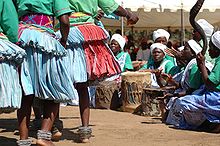Tsonga (ethnic group)
The Tsonga , also Shangana Tsonga or Shangaan are a Bantu - ethnic group in southern Africa . Their language is the Xitsonga ("Schi-tsonga"). They live mainly in southern Mozambique in the provinces of Gaza and Maputo . There is also a large group of Tsonga in Limpopo Province in South Africa .
history
Once the Tsonga ruled the Gaza Empire, which was founded by Soshanhaane . The capital was in Mossurize on today's border with Zimbabwe. The Gaza Empire stretched from parts of what is now southeastern Zimbabwe to the Save River in the southern part of Mozambique. Parts of the present-day provinces of Sofala , Manica , Inhambane , Gaza and Maputo in Mozambique and parts of South Africa belonged to him. Soshangaane moved the capital from Mossurize to Gaza Province. After his death, Muzila took over the rule. After Muzila, Gungunhana ruled , who was captured by the Portuguese in Mandlakazi, today's Gaza Province, in 1895.
During apartheid in South Africa , many Tsonga lived in the homeland Gazankulu in the northern Transvaal Province . In 1989 around 700,000 Tsonga lived in their homeland, while 470,000 lived outside. Tsonga mainly grow corn and also raise cattle.
music
The various traditional music styles are divided according to the seasonal events and festivals at which they are usually performed. Furthermore, vocal music and musical instruments are associated with specific gender-age classes. The musical diversity goes back in part to takeovers from the Khoisan and Dutch settlers. The pre-colonial musical instruments of the Tsonga and neighboring peoples include mouth bows and musical bows reinforced with calabash resonators . Harmonic structures are poorly developed, the songs are often limited to two alternating chords, rarely pentatonic , instead often chromatic without a specific key. A parallel polyphony is characteristic . Rural music is not an end in itself, it is mainly used to accompany dances.
The stringed instruments include the xitende musical bow with calabash, played by wandering storytellers . Only girls play the mouth arch xipendana with the strings divided in the middle. Older men and occasionally their daughters play the mqangala , which is made of a reed mouth . With the scrap bow xizambi , a wooden stick is rubbed over the ribbed surface of the string support. Its volume and the range from the second to the seventh overtone make it suitable for solo playing.
The large tumbler drum ndzumba has a ritual meaning as a fertility symbol and is used in the initiation schools of girls. The rattles of fruit pods marhonge , which are tied to the legs while dancing, in order to let the gods speak to the rhythm of the dance steps, are considered to be the abode of ancestral spirits . The mohambi is a frame xylophone with calabash reinforcement like the valimba in Malawi or the timbila in Mozambique . The Tsonga have a lamellophone called timbila , which is placed in a cut kerosene barrel to amplify the sound.
Instruments are the flute xitiringo with three fingers holes from reed or a metal tube and the ritual used Kuduhorn that mhalamhala is called.
Individual evidence
- ^ Thomas F. Johnston: Tsonga Musical Performance in Cultural Perspective (South Africa). In: Anthropos, Volume 70, Issue 5./6, 1975 pp. 761-799
